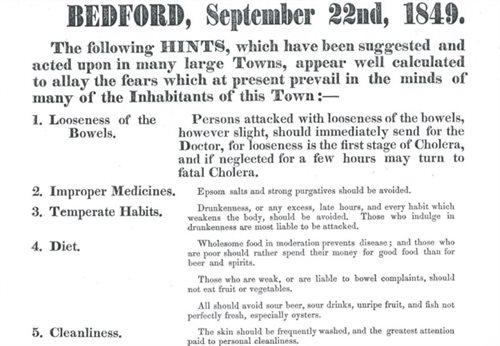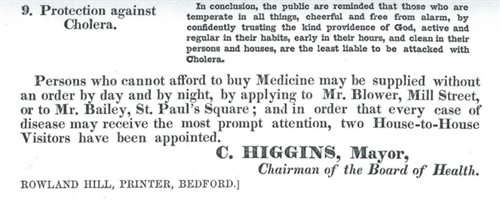Cholera in Little Staughton
This page was written by Brenda Foster and Jeanette Atkinson
Cholera, originally known as Asiatic Cholera but thought to come from the Indian subcontinent, killed many people in England from 1832 to the late 1800’s. The infection of the small intestine by some strains of Vibrio cholera caused vomiting and diarrhoea resulting in dehydration and death in the worst cases. There were four separate outbreaks during the years of 1832/3, 1848/9, 1854 and 1866. The Bedfordshire Mercury newspaper of October 20, 1866 cites the Lancet medical journal as reporting that a total of 37,769 deaths had occurred (6,729 in1832/3; 14,573 in 1848/9; 11,565 in 1854; and 4,902 in 1866). Joyce Godber in her History of Bedfordshire noted that the development of towns did not help as conditions were crowded and insanitary and none had a piped water supply; this encouraged epidemics and the worst was cholera.
One of the earliest deaths from Asiatic Cholera was that of Dr Joseph Thackeray of the Bedford County Hospital who died on 13 July 1832 (BHRS Vol 72, p.198). By 1849 the outbreak in Bedford was described as ‘making fearful progress’. House to house visitation was requested to halt the progression of the epidemic and posters were created by the Poor Law Board and Board of Health telling people how to manage their living conditions (PUBC 2/5 Part 2):

This poster produced by C Higgins, Mayor of Bedford in September 22nd 1849 concluded that:

A fatal case of cholera in Little Staughton, which by this time was called English Cholera, was reported by the Bedfordshire Times on February 4th 1854. The deceased, John Barrington aged 18 years, was ‘seized with severe pain in the bowels and vomiting’. Salt and water was given, which afforded some relief but ginger all spice with water made little difference. By the time John’s mother returned from a neighbour with a little brandy, John was dying. Mr Heming the surgeon gave evidence at the inquest and was of the opinion that English Cholera caused John’s demise (Bedfordshire Times, 4 February 1854).
Parish burial records do not indicate how many more Little Staughton residents died of Cholera from 1832 to the end of the 1880’s but it is likely that there were more than just John Barrington’s death in these epidemics.